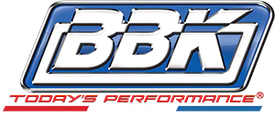Tech Guide - Fuel System
As with all BBK performance products, each of our fuel system components is built here in the USA on our state of the art CNC machining centers using a host of high quality components to ensure a perfect fit for everyday driving or to hold up under the pressure of weekend racing. Our popular adjustable fuel regulators & high flow aluminum fuel rails feature a beautiful anodized finish to not only hold up to the elements but also improve under hood looks. Be sure to check out this website for the BBK performance fuel system components available for your favorite car, truck or SUV.
|
BBK’s fuel pressure regulators should come preset from the factory at around 39-40psi. If you need to adjust for either higher or lower pressure you can. You’ll first want to loosen the regulators locking nut by rotating it counter clockwise. You can then use an allen-key to adjust pressure up (clockwise) or down (counter-clockwise) to your liking. Once you’ve achieved your desired pressure, make sure you tighten the locking nut into place. For the most accurate pressure readings, be sure to check out BBK’s Fuel Pressure Gauge Part #1617. (Parts possibly affected: 1706, 1707, 1714) |
|
The gauge kit comes with an adapter to allow you to attach it to the schrader valve, which is located on the fuel rail at the front of the motor on the passenger side. This is the port that you use to relieve fuel pressure from your system, and will work equally well to take a pressure reading. Here, you will have better viewing capabilities than on the regulator itself. The port on the top of the regulator is mainly for those customers wishing to run a remote line to the cab for mounting purposes there. |
|
The BBK Fuel pressure regulator is not a boost referencing model, meaning that forced induction systems will require the use of an FMU (Fuel Management Unit), usually supplied with the supercharger kit. (Part numbers affected include: 1706, 1707, 1617) |
|
This BBK kit utilizes the same diaphragm that is on your car. Simply remove the non-adjustable lid per the supplied instructions, and reinstall the BBK adjustable piece. This will offer the same reliable seal as the factory unit, while allowing full adjustability of your fuel pressure. (Part numbers affected include: 1714) |
|
Only a few of our pump offerings come with any wiring harnesses or hoses, as they won't adapt directly without them. Most will be able to retain the factory harness, and should be fine for use as you received it. (Part numbers affected include: 1526, 1527, 1606, 1607, 1621, 1622, 1625, 1626, 1627, 1630) |
|
The in-line pump from BBK was designed as a puller pump, to be used in-line with an in-tank pump to give greater potential to the overall system. It was not designed to be used as a primary pump. (Part numbers affected include: 1602) |
|
The 1602 in-line pump was designed as an additional puller pump. The pump should allow just about anyone looking to add a puller pump to their arsenal the ability to increase fuel pressure safely and effectively. However, the fittings that are supplied with the kit are specifically for a Ford application. This means that if you plan on running the pump on another application, you will most likely need to adapt those fittings for your particular use or locate some that will work as replacements for the supplied ones. (Part numbers affected include: 1602) |
|
So long as your pressure remains relatively constant while running (which it should), you shouldn't have to worry about that leak-down when the car is not running. In fact, we believe that a little bit of leak-down is healthier for the system, as it will relieve the pressure in the fuel system when not in use, which could possibly help extend the life of your equipment. The only real downside to the leak-down is that your pump might have to gear up a half-second longer when you first turn your car on; but then again, even the stock regulator has a slow leak-down rate, which eventually will lower the pressure to the same levels, so depending on how long your car sits in between starts, it could even be a moot point! (Part numbers affected include: 1617, 1706, 1707, 1714, 1526, 1527, 1606, 1607, 1621, 1622, 1625, 1626, 1627, 1630) |
|
In the 1998 model year, Ford switched their fuel system to a return-less system. The model years previous to this used a physical regulator and a constant-velocity fuel pump to regulate the pressure throughout the system. The older style system constantly supplies a fairly standard pressure (depending on load), the regulator only allows a certain amount of that pressure into the fuel system, and the excess fuel and pressure is bled back to the fuel tank. On the newer design, the fuel pump is a completely different design that works with varying pulses of voltage, and the computer monitors and controls the fuel pressure. Basically, the ECU (Engine Control Unit) controls the fuel pressure by telling the pump to speed up when the engine is under load, and tells it to slow down when you are just cruising, constantly varying the pump speed to control pressure in the system. While the newer style pumps can be adapted to be used in older applications, the older-style pumps and systems will not adapt to the newer-style ones. |
|
The BBK regulator is not designed to regulate pressure below the stock setting of about 38 psi. it should allow plenty of adjustability from stock settings and up, to allow high-horsepower engines that need the extra pressure over stock in order to achieve more fuel flow at high RPM's. (Part numbers affected include: 1526, 1527, 1606, 1607, 1621, 1622, 1625, 1626, 1627, 1630) |




